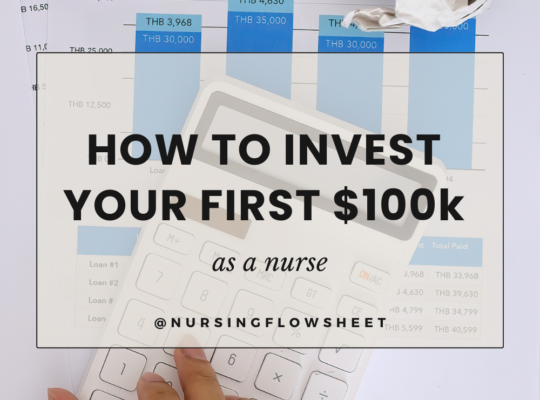I often hear people say that retirement is not an age- but a number. As a nurse, retirement is something that needs to be planned early on in your profession. This provides you with a good idea of how much you need to be investing or saving to reach that goal of making work optional.
One of the questions I always get is “How much do I need for Retirement as a Nurse?” “How much should I be investing?”
My answer, my favorite one is “IT DEPENDS”.
A precise retirement savings target has several benefits. It helps you figure out how much to put into 401(k)s and other investment accounts each month and how to arrange your investments so that you’re not risking too much—or too little—in the decades leading up to retirement.
Some people even build retirement around a savings target rather than a date. Instead of working until a certain age, they work until they hit their mark or FREEDOM NUMBER.

Here are some simple guidelines to consider when pricing your retirement.
Average retirement savings by age
Let’s start by taking a look at the average retirement savings by age in the U.S. based on the Federal Reserve’s 2022 Survey of Consumer Finances.
| Age | Average retirement savings (2022) | Median retirement savings (2022) |
| Under 35 | $49,130 | $18,880 |
| 35 to 44 | $141,520 | $45,000 |
| 45 to 55 | $313,220 | $115,000 |
| 55 to 64 | $537,560 | $185,000 |
| 65 to 74 | $609,230 | $200,000 |
| 75 or older | $462,410 | $130,000 |
The average saver between ages 35 and 44 has $141,520 saved. People in the next age group, 45 to 55, have more than double that amount—$313,220—stashed away, on average. The older people are, the higher their savings tends to be—until about age 75, when the average balance starts to decline as retirees spend down their investments.
Averages, however, can be deceiving. Very high or very low balances can skew the numbers. The median savings by age, while lower, represents a more accurate picture of how much the typical saver has set aside for retirement.
While this data can be interesting as a point of comparison, using it to choose your retirement savings target isn’t the best approach. Most Americans should be aiming much higher to fund a comfortable retirement, research shows.
How much money do I need to retire: three guidelines to consider
When we talk about how much money we need in retirement, we’re really trying to predict two things: how much you’re likely to spend in a year and how many years you’ll be retired.
Here are three methods to estimate your retirement spending.
1. 80% of your preretirement income
Over decades of helping people plan for retirement, the financial planning industry has figured out that most retirees can live on less than they earned during their working years.
“Replacing 80% of your income means your lifestyle can essentially stay the same,” Hindert says. That’s because, once you retire, you’re no longer paying Medicare and Social Security taxes or making contributions to a 401(k) or IRA.
Additionally, you probably don’t have to pay for things such as weekly dry cleaning or commuting to an office (though some of us already gave those expenses up when working from home became more common). If you pay off your mortgage and debts before retiring, you could live on smaller portion of your preretirement income.
Based on this rule, if your annual preretirement income was $100,000, you need $80,000 a year in retirement to cover your expenses. Some of that will come from Social Security benefits, which you can estimate using this calculator, or perhaps a pension or annuity. However, most people will need to get the majority of their retirement income from a 401(k), IRA or other savings.
Let’s say you collect annual Social Security and pension income of $30,000, after taxes. Sticking with the $80,000 example, that means you need an additional $50,000 in income a year.
Assuming an inflation rate of 4% and a conservative after-tax rate of return of 5%, you should aim for a savings target of $1.3 million to fund a 30-year retirement that begins at age 67. This would give you an investment portfolio that produces about $50,000 a year in income.
2. 10x your annual salary by 67
The financial-services firm Fidelity suggests that savers can target a much lower income replacement percentage than 80%. To maintain a lifestyle similar to the decade before retirement, a 45% income replacement target is sufficient. To achieve that, Fidelity recommends aiming for the following age-based savings targets:
| Your age | Savings target by salary multiple |
| 30 | 1x |
| 35 | 2x |
| 40 | 3x |
| 45 | 4x |
| 50 | 6x |
| 55 | 7x |
| 60 | 8x |
| 67 | 10x |
Fidelity says you should be able to meet these targets if you start saving at age 25 and invest 15% of your annual income in an age-appropriate mix of stocks and bonds. In general that means keeping the bulk of your investments in stocks when you’re young. As you approach retirement, shifting into bonds and cash can add stability to your portfolio.
To fund an “above average” retirement lifestyle—where you spend 55% of your preretirement income—Fidelity recommends having 12 times your income saved at age 67, which is the normal Social Security retirement age. That multiple can creep up if you plan to claim benefits earlier than 67 or you have a long life expectancy.
Fidelity based its benchmarks on an analysis of household survey data from the Bureau of Labor Statistics for working people aged 50 to 65, which measures how much people spend on everything from housing and food to healthcare and transportation. Your own budget may vary, which is why it’s important to do an analysis of your spending before setting a savings target (more on that below).
3. The 4% rule (FREEDOM NUMBER CALCULATION)
Another method to project how much money you’ll need in retirement is the 4% rule.
That’s a framework proposed in the 1990s by a now retired financial advisor, and supported by investment research from Morningstar, that shows retirees can safely withdraw 4% of their portfolio in the first year of retirement. If they adjust subsequent annual withdrawals for inflation, they should not run out of money in most market conditions. The idea is that your investment earnings and appreciation keep you ahead of inflation.
To find your savings target, multiply your projected annual spending by your projected years in retirement.
For example, if you need your nest egg to generate $60,000 annually and you anticipate 25 years in retirement, you need $1.5 million. In this case there’s a 95% chance your savings will last, according to Vanguard’s retirement calculator, if half of the portfolio is invested in stocks, 30% in bonds and 20% in cash.
You can also use PENSIONBEE’s Calculator.

How much money do I need to retire: personal factors to consider
Of course, the guidelines are just a starting point. It’s important to consider a range of personal factors to fine-tune your retirement savings target.
Your retirement location
Two people living in different parts of the U.S. will have different retirement income needs, in some cases vastly so. Additionally, if you plan on living abroad, your living expenses will be significantly lower as well.
Projecting your cost of living in retirement will be fairly straightforward if you plan to stay put, since you know the typical cost of dining out, entertainment, medical care and other daily purchases.
Your retirement spending
If you’re within a decade of retirement, put a finer point on your spending projections by taking a close look at current monthly expenses and whether those might change when you’re no longer working. Commuting costs, for example, will fall off your budget but healthcare spending could grow with age.
It’s also important to think about significant expenses on the horizon, she adds, such as putting a kid (or two) through college or paying rent. If you own your home, do a home assessment to identify any large projects, such as a renovation or a roof replacement, that you can pay for before you retire or sell your home. “It’s easier to do that when you have income coming in,” she says.
Your retirement date
Along with retirement date, You should also think about when you’re going to start collecting Social Security. Social Security benefits for someone retiring at 65 replace about 30% to 50% of prior earnings—the replacement share is higher for those at the lower end of the income spectrum. The longer you wait to claim, up to age 70, the more you can collect.
Where to keep your retirement savings
If your job offers a 401(k) or 403(b), don’t sleep on it. Employer-sponsored retirement plans are the best place to start your savings journey. You can fund them with up to $23,000 in 2024 and get a tax break for it—a benefit that’s missing from traditional investment or brokerage accounts.
If you don’t have access to a 401(k) or similar plan at work, or you need to save more than the plan allows, consider other investment accounts like ROTH IRA or traditional IRAS These accounts offer comparable tax benefits, a wider selection of investments and greater withdrawal flexibility.
In conclusion,
Retirement is a personal plan that all nurses should start thinking about early in their career. This provides a good target of how much you should be allocating for the future. There are so many things to consider including retirement needs. While there are benchmarks when it comes to retirement savings, everyone has different visions and goals of how they want to spend their retirement and how much you should be saving should depend on that goal.





